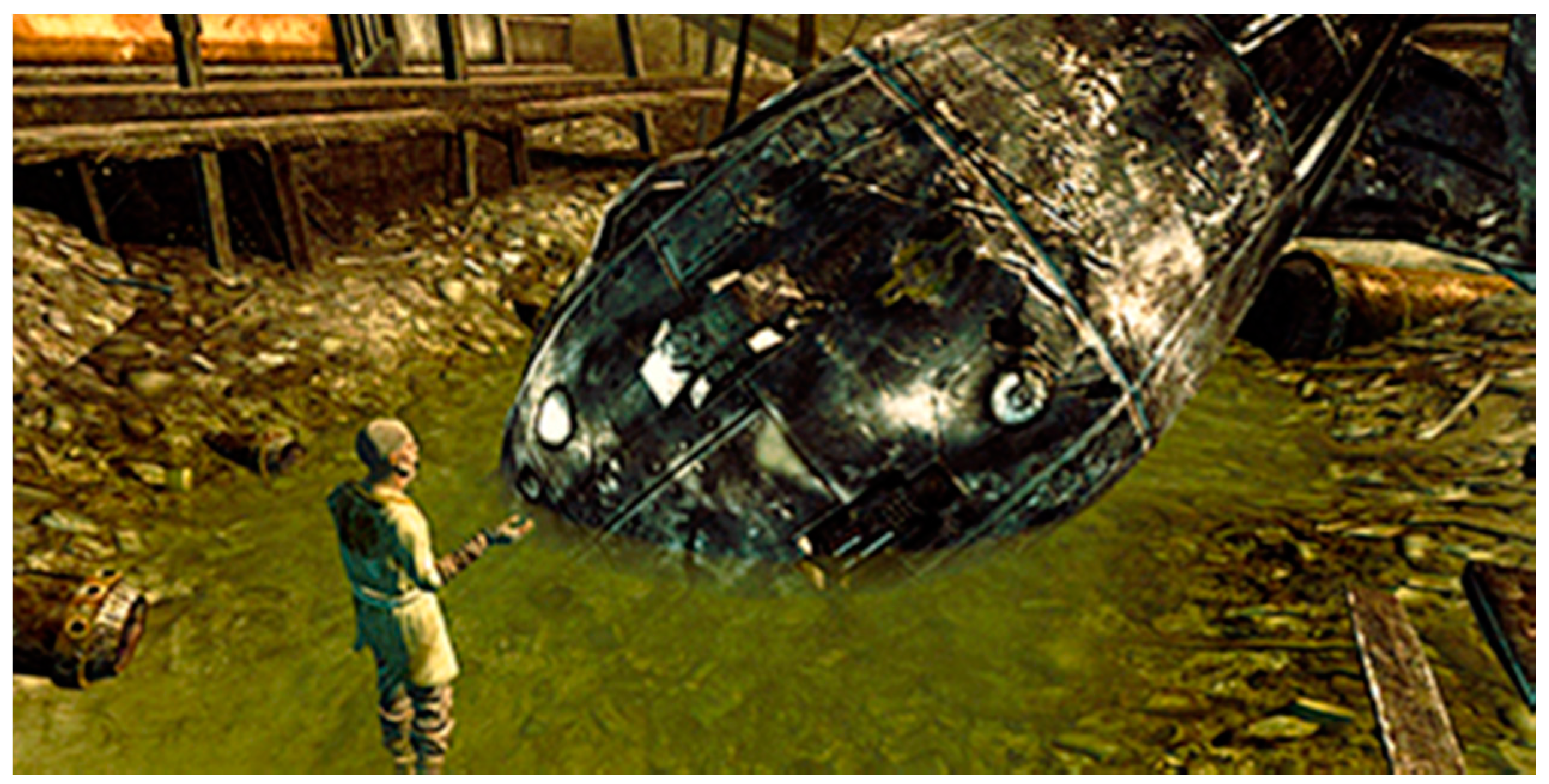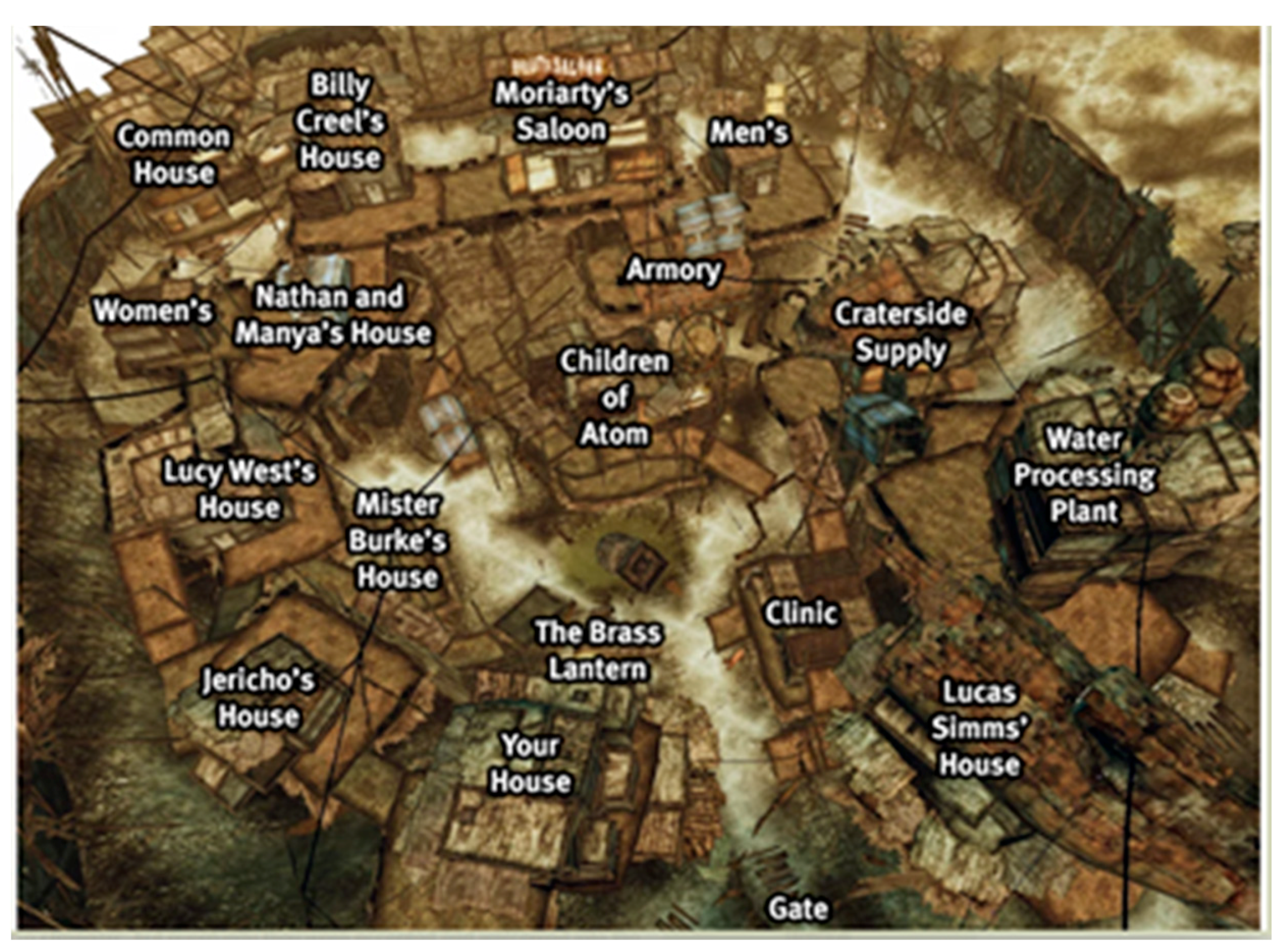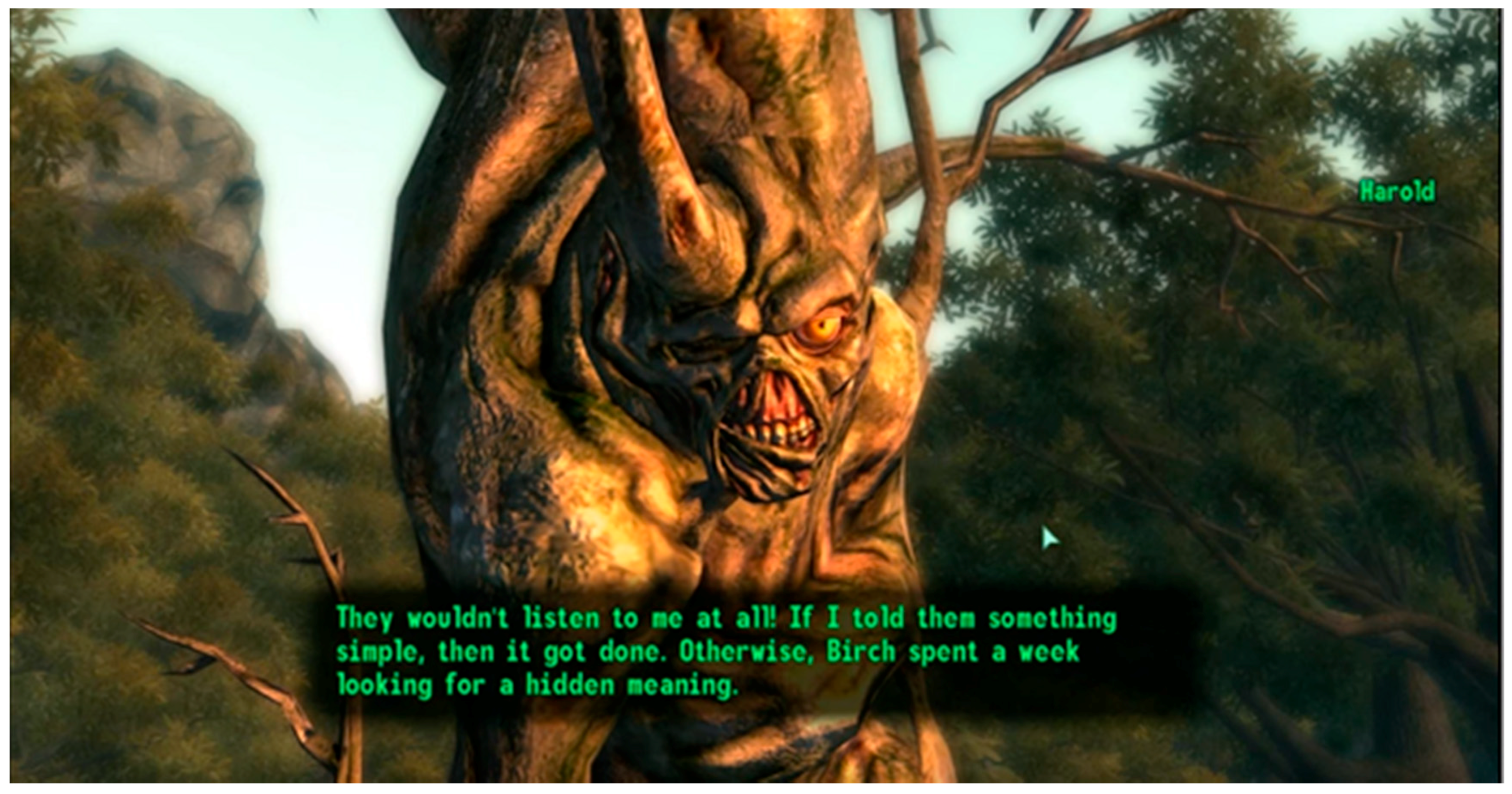‘Things Greater than Thou’: Post-Apocalyptic Religion in Games
Abstract
:- Aloy:
- “Why are the lands beyond Nora territory called ‘tainted’?”
- Teersa:
- “Is it not obvious? Our land is sacred. We live in sight of the one Goddess, All-Mother—source of all that lives. Beyond her sight lies a vast fallen land, spiritually tainted. That is why it is against tribal law to leave. But this blessing will protect you.”
1. Revelations of a New World
2. Religion in Games: History, Fantasy and Future
2.1. Fantasy Fiction-Based Religion: A Strong Bias
2.2. Science Fiction-Based Religion: A Blind Spot
Such (evolutionary) arguments about rationalism, science, and technology as an “irreligious power” (Ibid., p. 142), are deeply institutionalized in the social sciences, and may account for the fact that debates on fiction-based religion generally show a bias towards the fantasy genre and a blind spot for the sci-fi genre.“One need no longer have recourse to magical means to master or implore the spirits, as did the savage, for whom such mysterious powers existed. Technical means and calculation perform the service”
3. Post-Apocalyptic Religion
3.1. Fallout 3: “Why Do You Worship the Bomb?”
- Confessor Cromwell:
- “The Church of the Children of Atom is based on the idea that each single atomic mass in all of creation contains within it an entire universe. When that atomic mass is split, a single universe divides and becomes two—thus signifying the single greatest act of Atom’s creation.
- Occasionally, a divine event occurs and trillions upon trillions of new universes are created. The last such event took place here, 200 years ago. Where most of the lost children of Atom see that event as simple war and devastation, we see creation and unification in Atom’s Glow.”
- Lone Wanderer [Player-character]:
- Why do you worship the bomb?
- Confessor Cromwell:
- “Those who were called to Atom during the Great Division were very fortunate. They were permitted to aid in the process of Atom’s creation. We seek the same, both in symbol and in fact and the ’bomb,’ as you call it, represents Atom’s capacity for creation. We kneel before it and ask that Atom call us to aid him. We pray that out of our meager bodies, he will create new life.”
“Give your bodies to Atom, my friends. Release yourself to his power, feel his Glow and be Divided.Yea, your suffering shall exist no longer; it shall be washed away in Atom’s Glow, burned from you in the fire of his brilliance.Come forth and drink the water of the glow. For this ancient weapon of war is our salvation, it is the very symbol of Atom’s glory. Let it serve as a reminder of the division that has occurred in the past.”
“That is Atom’s unique gift to us, the true believers.He has brought us here to this place, a place that cannot harm us, so that we may worship him. So that we may spread his word to others.That is our calling. To deliver Atom’s message to a world that does not wish to hear it. To show Atom's power to all.”
3.2. Horizon: Zero Dawn, “Mother Nature as an AI and the Ultimate Killer App”
- Elisabeth Sobeck:
- “What if we could give life—a future? What if we could build a kind of seed, from which, on a dead planet, life could blossom anew? This is the aim—the hope–of Project: Zero Dawn: to create a super-intelligent, fully-automated terraforming system—and bring life back from lifelessness. What would such a system require? At its core, it would need a true AI. Fully capable of making the trillions of decisions necessary to reconstitute the biosphere. An immortal guardian, devoted to the re-flourishing of life. We call it GAIA. Mother Nature as an AI.”
“A super intelligent, fully-automated terraforming system. […] [a] true AI. Fully capable of making the trillions of decisions necessary to reconstitute the biosphere. An immortal guardian, devoted to the re-flourishing of life. We call it GAIA. Mother Nature as an AI.”
4. Conclusions
“He is wise in heart and mighty in strength, who has defied Him without harm? It is God who removes the mountains, they know not how, when He overturns them in His anger; who shakes the earth out of its place, And its pillars tremble; who commands the sun not to shine, and sets a seal upon the stars; who alone stretches out the heavens and tramples down the waves of the sea; who makes the Bear, Orion and the Pleiades, and the chambers of the south; who does great things, unfathomable, and wondrous works without number.”(Job 9:4–10)
Even when we contrast the Church of the Children of Atom to their obvious counterpart, the role of religion in making sense of the post-apocalypse becomes clear. That is, whereas the Treeminders form a Church based on nature instead of science—worshipping a forest, rather than the periodic table—and on creation instead of destruction. Both are ways of coping with man-made disaster, and the atomic power that led to the barren post-apocalyptic wasteland of Fallout. More importantly, both are specifically new, uniquely technology-driven ways of coping with the apocalypse that are enabled only after the erasure of pre-existing institutions and traditions of worship after the fallout.“Behold! He’s coming with the clouds! And every eye shall be blind with his glory! Every ear shall be stricken deaf to hear the thunder of his voice!Each of us shall give birth to a billion stars formed from the mass of our wretched and filthy bodies.”
Author Contributions
Funding
Acknowledgments
Conflicts of Interest
References
- Aarseth, Espen. 2001. Computer game studies, year one. Game Studies 1: 1–15. [Google Scholar]
- Aupers, Stef. 2007. “Better than the real world”. On the Reality and Meaning of Online Computer Games. Fabula 48: 250–69. [Google Scholar] [CrossRef]
- Aupers, Stef. 2009. The force is great: enchantment and magic in silicon valley. Masaryk UJL & Tech 3: 153. [Google Scholar]
- Aupers, Stef, and Dick Houtman. 2010. Religions of Modernity: Relocating the Sacred to the Self and the Digital. In Religions of Modernity. Leiden: Brill, pp. 1–30. [Google Scholar]
- Aupers, Stef, Houtman Dick, and Peter Pels. 2008. Cybergnosis: Technology, Religion and the Secular. In Religion: Beyond a Concept. New York: Fordham University Press. [Google Scholar]
- Aupers, Stef, Schaap Julian, and Lars de Wildt. 2018. Qualitative In-Depth Interviews: Studying Religious Meaning-Making in MMOs. In Methods for Studying Video Games and Religion. Edited by Vit Sisler, Kerstin Radde-Antweiler and Xenia Zeiler. London: Routledge. [Google Scholar]
- Bainbridge, William Sims. 2013. EGods: Faith versus Fantasy in Computer Gaming. Oxford: Oxford University Press. [Google Scholar]
- Bainbridge, William Sims. 2016. Virtual Sociocultural Convergence. Basel: Springer International Publishing. [Google Scholar]
- Benedikt, Michael. 1992. Cyberspace: First Steps. Cambridge: MIT Press. [Google Scholar]
- Berger, Peter. 1967. The Sacred Canopy: Elements of a Sociological Theory of Religion. New York: Doubleday. [Google Scholar]
- Bleiler, Everett Franklin. 1990. Science-Fiction, the Early Years: A Full Description of More Than 3,000 Science-Fiction Stories from Earliest Times to the Appearance of the Genre Magazines in 1930: With Author, Title, and Motif Indexes. Kent: Kent State University Press. [Google Scholar]
- Bosman, Frank. 2016. The Word Has Become Game: Researching Religion in Digital Games. Online Heidelberg Journal of Religions on the Internet 11: 28–45. [Google Scholar]
- Bosman, Frank. 2017. There Is No Solution! “Wicked Problems” in Digital Games. Games and Culture, 1–7. [Google Scholar] [CrossRef]
- Bosman, Frank, and Marcel Poorthuis. 2015. Nephilim: The Children of Lilith. The Place of Man in the Ontological and Cosmological Dualism of the Diablo, Darksiders and Devil May Cry Game Series. Online-Heidelberg Journal of Religions on the Internet 7: 190–207. [Google Scholar] [CrossRef]
- Cavallaro, Dani. 2000. Cyberpunk and Cyberculture. London and New Brunswick: Athlone Press. [Google Scholar]
- Copier, Marinka. 2005. Connecting worlds. Fantasy role-playing games, ritual acts and the magic circle. Paper presented at DiGRA 2005 Conference: Changing Views—Worlds in Play, Vancouver, BC, Canada, June 16–20. [Google Scholar]
- Curry, Patrick. 1998. Defending Middle-Earth: Tolkien, Myth & Modernity. London: Harper Collins Publishers. [Google Scholar]
- Curry, Patrick. 1999. Magic vs. enchantment. Journal of Contemporary Religion 14: 104–12. [Google Scholar] [CrossRef]
- Curry, Patrick. 2005. Tolkien and his critics: A critique. Root and Branch—Approaches Towards Understanding Tolkien 119: 81–148. [Google Scholar]
- Davidsen, Markus Altena. 2013. Fiction-based religion: Conceptualising a new category against history-based religion and fandom. Culture and Religion 14: 378–95. [Google Scholar] [CrossRef]
- Davis, Erik. 1998. TechGnosis. Myth, Magic and Mysticism in the Age of Information. New York: Three Rivers. [Google Scholar]
- De Wildt, Lars. 2014. Precarious play: To be or not to be Stanley. Press Start 1: 1–20. [Google Scholar]
- De Wildt, Lars, and Stef Aupers. 2017. Bibles and BioShock: Affording Religious Discussion on Video Game Forums. In Proceedings of the Annual Symposium on Computer-Human Interaction in Play. New York: ACM, pp. 463–75. [Google Scholar]
- De Wildt, Lars, and Stef Aupers. 2018. Playing the Other: Role-Playing Religion in Videogames. European Journal of Cultural Studies 21. forthcoming. [Google Scholar]
- Dery, Mark. 1996. Escape Velocity: Cyberculture at the End of the Century. New York: Grove Press. [Google Scholar]
- Dinello, Daniel. 2005. Technophobia!: Science Fiction Visions of Posthuman Technology. Austin: University of Texas Press. [Google Scholar]
- Fallout Wikia. n.d. Available online: http://fallout.wikia.com/wiki/Fallout_Wiki (accessed on 1 May 2018).
- Fine, Gary Alan. 1983. Shared Fantasy: Role Playing Games as Social Worlds. Chicago: University of Chicago Press. [Google Scholar]
- Fitting, Peter. 2010. Utopia, dystopia and science fiction. In The Cambridge Companion to Utopian Literature. Cambridge: Cambridge University Press, p. 135. [Google Scholar]
- Frasca, Gonzalo. 2003. Ludologists love stories, too: Notes from a debate that never took place. Paper presented at Digital Games Research Conference, Utrecht, The Netherlands, November 4–6. [Google Scholar]
- Geraci, Robert. 2012. Apocalyptic AI: Visions of Heaven in Robotics, Artificial Intelligence, and Virtual Reality. Oxford: Oxford University Press. [Google Scholar]
- Gregory, Rabia. 2014. Citing the Medieval: Using Religion as World Building Infrastructure in Fantasy MMORPGs. In Playing with Religion in Digital Games. Edited by Heidi Campbell and Gregory Price Grieve. Bloomington: Indiana University Press. [Google Scholar]
- Grimal, Pierre. 1996. The Dictionary of Classical Mythology. Hoboken: Wiley-Blackwell. [Google Scholar]
- Guyker, Robert William. 2014. The Mythic Scope of Journey. A Comparative Assessment Concerning the Spirit at Play and Cybernetic Shamanism. Online-Heidelberg Journal of Religions on the Internet 5: 317–52. [Google Scholar] [CrossRef]
- Heidbrink, Simone, Tobias Knoll, and Jan Wysocki. 2014. Theorizing religion in digital games. Perspectives and approaches. Online-Heidelberg Journal of Religions on the Internet 5: 5–51. [Google Scholar] [CrossRef]
- Heim, Michael. 1993. The Metaphysics of Virtual Reality. Oxford and New York: Oxford University Press. [Google Scholar]
- Horizon Zero Dawn Wikia. n.d. Available online: horizonzerodawn.wikia.com/wiki/Horizon_Zero_Dawn_Wikia (accessed on 1 May 2018).
- Huizinga, Jopie. 1970. Homo Ludens. London: Paladin. [Google Scholar]
- Jameson, Fredric. 1975. Magical narratives: romance as genre. New Literary History 7: 135–63. [Google Scholar] [CrossRef]
- Jenkins, Henry. 2006. Convergence Culture: Where Old and New Media Collide. New York: NYU Press. [Google Scholar]
- King, Brad, and John Borland. 2003. Dungeons and Dreamers: The Rise of Computer Game Culture. From Geek to Chic. New York and Chicago: McGraw-Hill. [Google Scholar]
- Krzywinska, Tanya. 2006. Blood Scythes, Festivals, Quests, and Backstories: World Creation and Rhetorics of Myth in World of Warcraft. Games and Culture 1: 383–96. [Google Scholar] [CrossRef] [Green Version]
- Kurzweil, Ray. 2005. The Singularity Is Near: When Humans Transcend Biology. London: Penguin. [Google Scholar]
- Latour, Bruno. 2012. We Have Never Been Modern. Boston: Harvard University Press. [Google Scholar]
- Leibovitz, Liel. 2014. God in the Machine: Video Games as Spiritual Pursuit. West Conshohocken: Templeton Foundation Press. [Google Scholar]
- Marett, Robert Ranulph. 1914. The Threshold of Religion. London: Methuen and Co. Ltd. First published 1909. [Google Scholar]
- Masso, Isamar Carrillo, and Nathan Abrams. 2014. Locating the Pixelated Jew. In Playing with Religion in Digital Games. Edited by Heidi Campbell and Gregory Price Grieve. Bloomington: Indiana University Press. [Google Scholar]
- Moravec, Hans. 1988. Mind Children: The Future of Robot and Human Intelligence. Boston: Harvard University Press. [Google Scholar]
- Murray, Janet Horowitz. 2005. The last word on ludology v narratology in game studies. Paper presented at International DiGRA 2005 Conference: Changing Views—Worlds in Play, Vancouver, BC, Canada, June 16–20. [Google Scholar]
- Noble, David. 1999. The Religion of Technology: The Divinity of Man and the Spirit of Invention. New York and London: Penguin Books. First published 1997. [Google Scholar]
- Otto, Rudoolf. 1987. Das Heilige. Über das irrationale in der idee des göttlichen und sein verhältnis zum rationalen. München: Verlag CH Beck. First published 1917. [Google Scholar]
- Popper, Ben. 2012. Rapture of the Nerds. The Verge, October 22. Available online: https://www.theverge.com/2012/10/22/3535518/singularity-rapture-of-the-nerds-gods-end-human-race (accessed on 1 May 2018).
- Possamai, Adam. 2005. Religion and Popular Culture: A Hyper-Real Testament. No. 7. Brussels: Peter Lang. [Google Scholar]
- Schaap, Julian, and Stef Aupers. 2017. ‘Gods in World of Warcraft exist’: Religious reflexivity and the quest for meaning in online computer games. New Media & Society 19: 1744–60. [Google Scholar]
- Šisler, Vit. 2006. Representation and self-representation: Arabs and Muslims in digital games. In Gaming Realities: A Challenge for Digital Culture. Athens: Fournos. [Google Scholar]
- Šisler, Vit. 2008. Digital Arabs: Representation in Video Games. European Journal of Cultural Studies 11: 203–20. [Google Scholar]
- Šisler, Vit. 2009. Palestine in pixels: The holy land, Arab-Israeli conflict, and reality construction in video games. Middle East journal of Culture and Communication 2: 275–93. [Google Scholar]
- Smith, William. 1872. Dictionary of Greek and Roman Biography and Mythology. London: John Murray. [Google Scholar]
- Stenger, Nicole. 1992. Mind Is a leaking Rainbow. In Cyberspace: First Steps. Edited by Michael Benedikt. Cambridge: MIT Press, pp. 49–58. [Google Scholar]
- Tolkien, John Ronald Reuel. 1939. On Fairy-Stories. Oxford: Oxford University Press, pp. 3–84. [Google Scholar]
- Turkle, Sherry. 2002. Our Split Screens. Etnofoor 15: 5–19. [Google Scholar]
- Wagner, Rachel. 2012. Godwired: Religion, Ritual and Virtual Reality. London: Routledge. [Google Scholar]
- Weber, Max. 1948. Science as a Vocation. In From Max Weber: Essays in Sociology. Edited by Hans Heinrich Gerth and Charles Wright Mills. London: Routledge, pp. 129–56. [Google Scholar]
- Wiemker, Markus, and Jan Wysocki. 2014. ‘When people pray, a god is born… This god is you!’ An Introduction to Religion and God in Digital Games. Online-Heidelberg Journal of Religions on the Internet 5: 197–224. [Google Scholar] [CrossRef]
- Zeiler, Xenia. 2018. Level Up: Methods for Studying Video Games and Religion. In Methods for Studying Video Games and Religion. London: Routledge, pp. 3–13. [Google Scholar]













| AI | Description | Mythology |
|---|---|---|
| AETHER | AETHER is the subfunction of GAIA dedicated to detoxifying the Earth’s ravaged atmosphere. | Personification of the upper sky. |
| APOLLO | APOLLO is the subfunction dedicated to the archival of human history and culture, and the education of new generations of humans born in Cradle facilities. | Greek god of the sun and light, music, truth and prophecy, healing, poetry. |
| ARTEMIS | ARTEMIS is the subfunction dedicated to the creation and reintroduction of animal life onto a newly-terraformed Earth. | Greek goddess of the hunt, wild animals, wilderness, childbirth, virginity and protector of young girls. |
| DEMETER | DEMETER is the subfunction dedicated to the replanting of the Earth from cryopreserved seed stocks. | Greek goddess of the harvest and agriculture |
| ELEUTHIA | ELEUTHIA is the subfunction dedicated to the cloning and raising of humans from genetic stock at specially designed and prepared Cradle facilities scattered across the Earth. | Greek goddess of childbirth and midwifery. |
| GAIA | GAIA is the main A.I. overseeing repopulation of the earth. GAIA and her subordinate functions are tasked with re-terraforming the Earth back to its pre-apocalyptic state. | Personification of the Earth. |
| HADES | HADES is the “extinction failsafe protocol”—the last resort for GAIA, which would allow it to destroy and reset the terraforming process when an undesirable outcome is detected. | Greek god of the dead, of the Underworld, darkness, the Earth, fertility, riches, mortality, afterlife and metal. |
| HEPHAESTUS | HEPHAESTUS is the subfunction dedicated to the construction of underground Cauldron facilities that would build the machines needed to complete the terraforming project. | Greek god of blacksmiths, metalworking, carpenters, craftsmen, artisans, sculptors, metallurgy, fire, and volcanoes. |
| MINERVA | MINERVA is the subfunction dedicated to the construction of massive communications arrays to broadcast the deactivation codes to the berserk apocalyptic robots. | Roman goddess of wisdom and strategic warfare. |
| POSEIDON | POSEIDON is the subfunction dedicated to detoxifying the Earth’s poisoned seas and oceans. | Greek god of the Sea and other waters; of earthquakes; and of horses. |
© 2018 by the authors. Licensee MDPI, Basel, Switzerland. This article is an open access article distributed under the terms and conditions of the Creative Commons Attribution (CC BY) license (http://creativecommons.org/licenses/by/4.0/).
Share and Cite
De Wildt, L.; Aupers, S.; Krassen, C.; Coanda, I. ‘Things Greater than Thou’: Post-Apocalyptic Religion in Games. Religions 2018, 9, 169. https://doi.org/10.3390/rel9060169
De Wildt L, Aupers S, Krassen C, Coanda I. ‘Things Greater than Thou’: Post-Apocalyptic Religion in Games. Religions. 2018; 9(6):169. https://doi.org/10.3390/rel9060169
Chicago/Turabian StyleDe Wildt, Lars, Stef Aupers, Cindy Krassen, and Iulia Coanda. 2018. "‘Things Greater than Thou’: Post-Apocalyptic Religion in Games" Religions 9, no. 6: 169. https://doi.org/10.3390/rel9060169
APA StyleDe Wildt, L., Aupers, S., Krassen, C., & Coanda, I. (2018). ‘Things Greater than Thou’: Post-Apocalyptic Religion in Games. Religions, 9(6), 169. https://doi.org/10.3390/rel9060169





